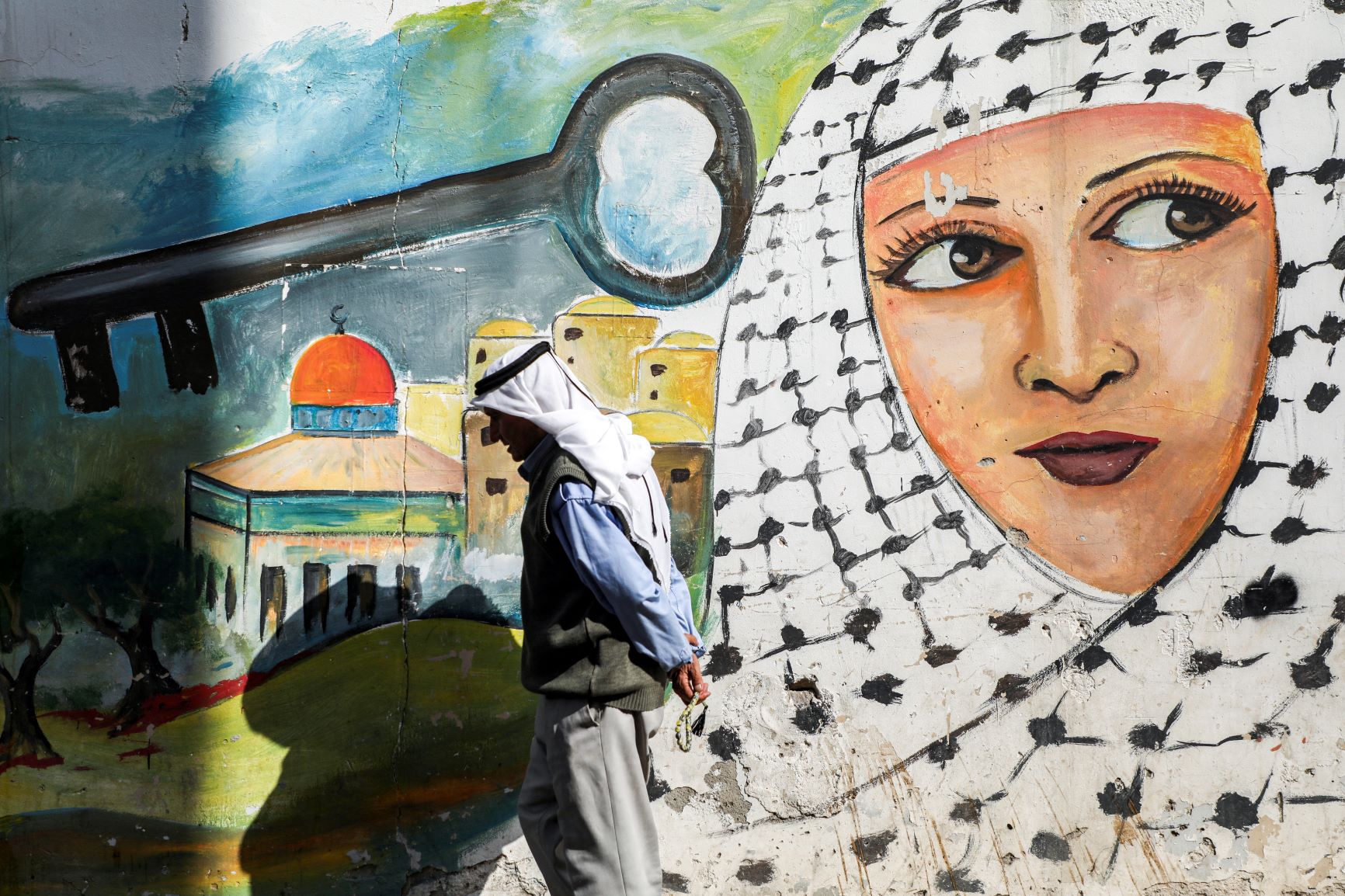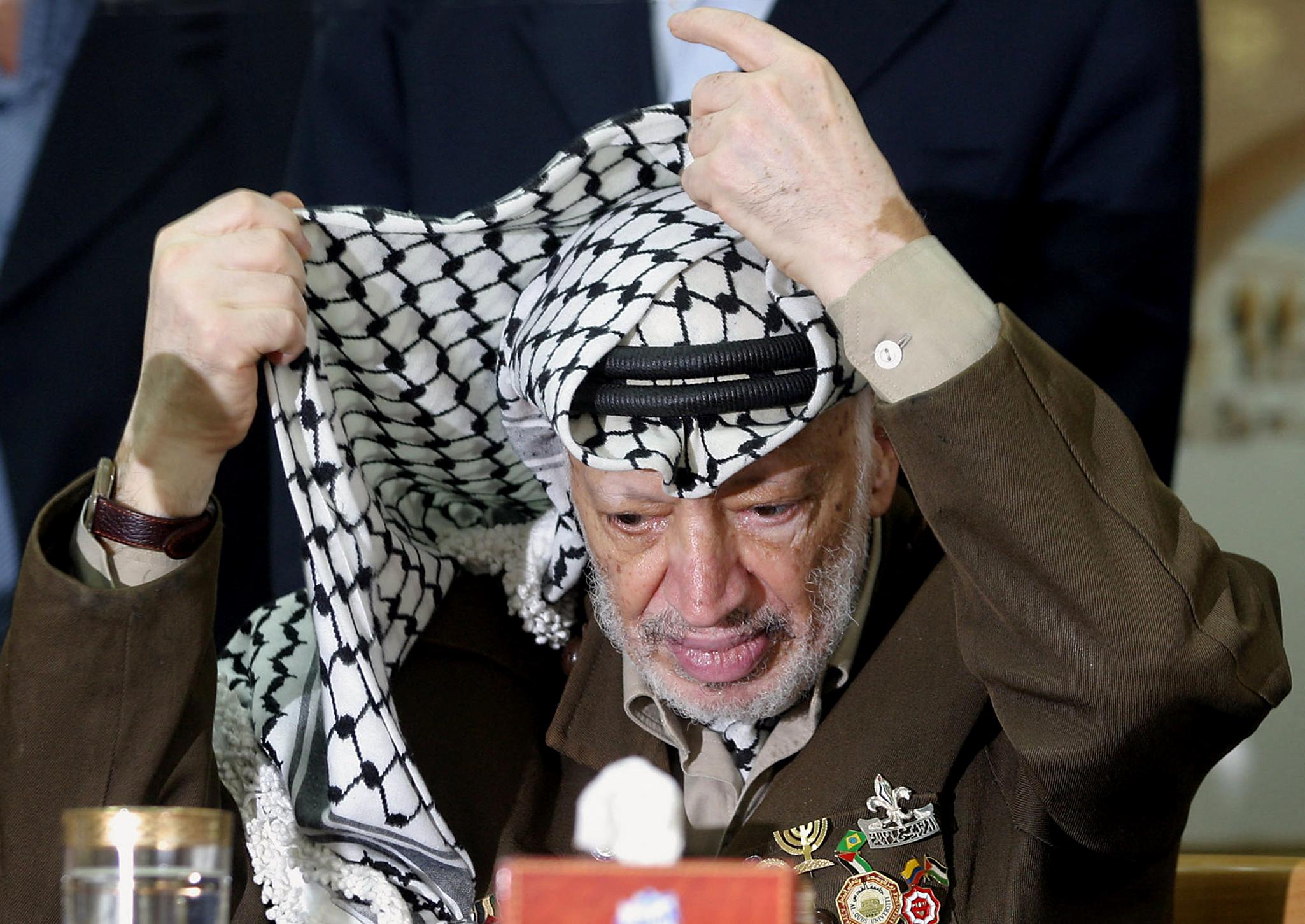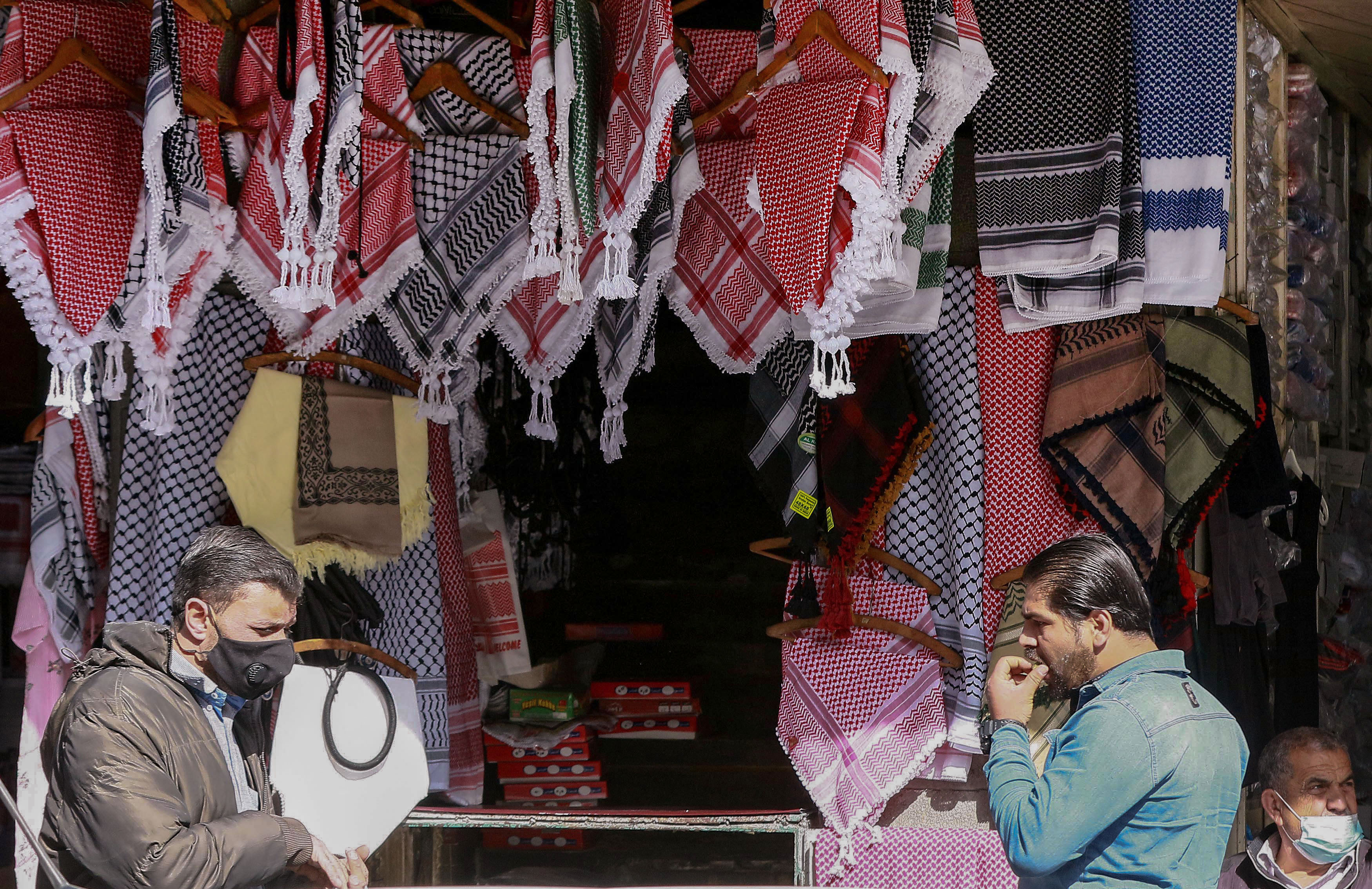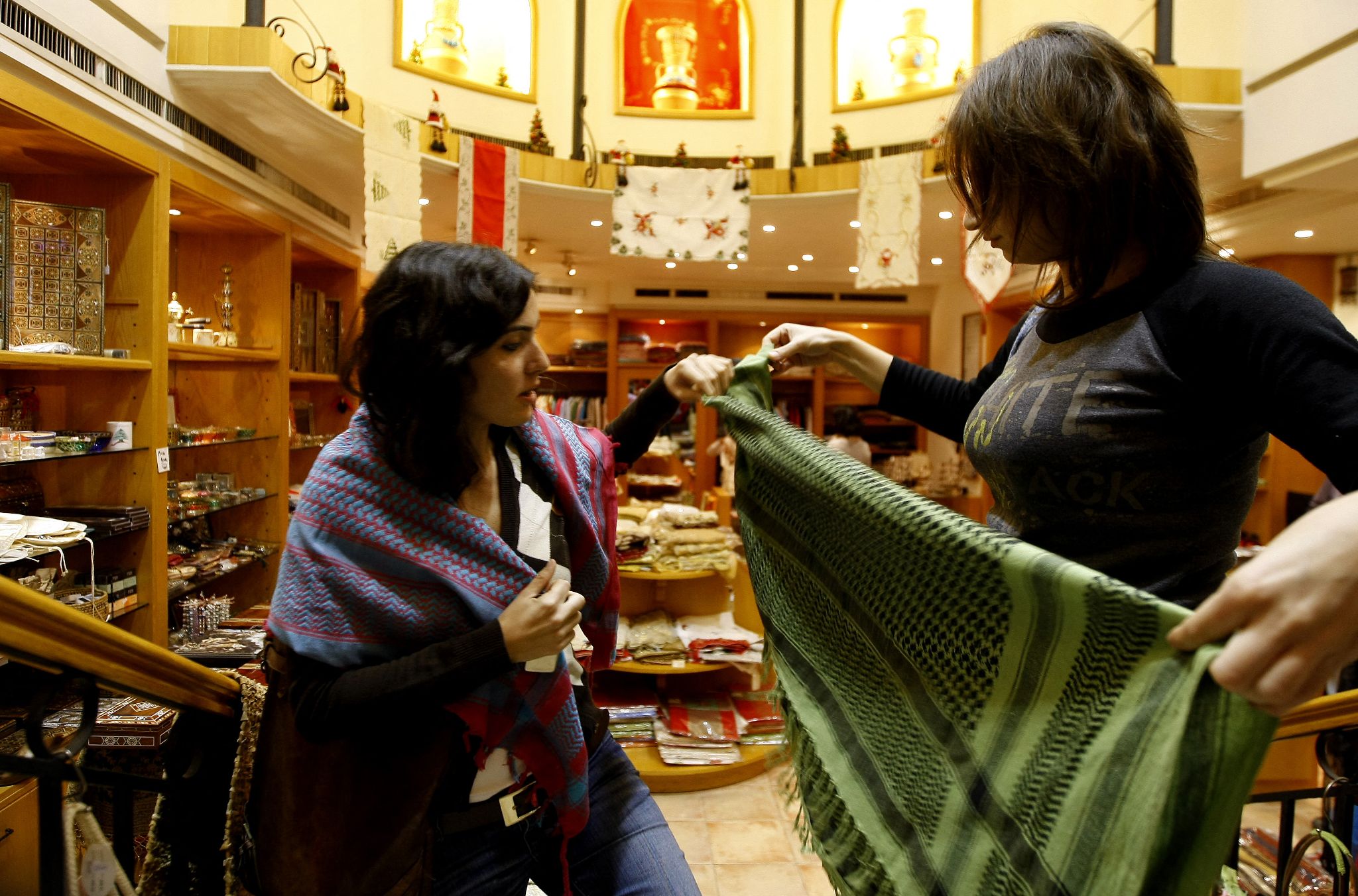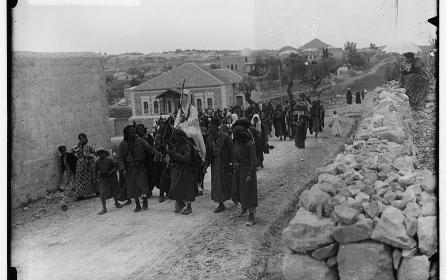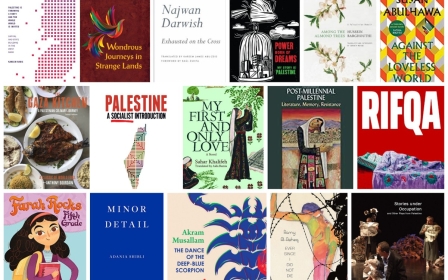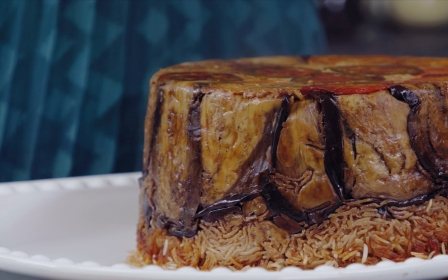The Palestinian keffiyeh: All you need to know about its origins
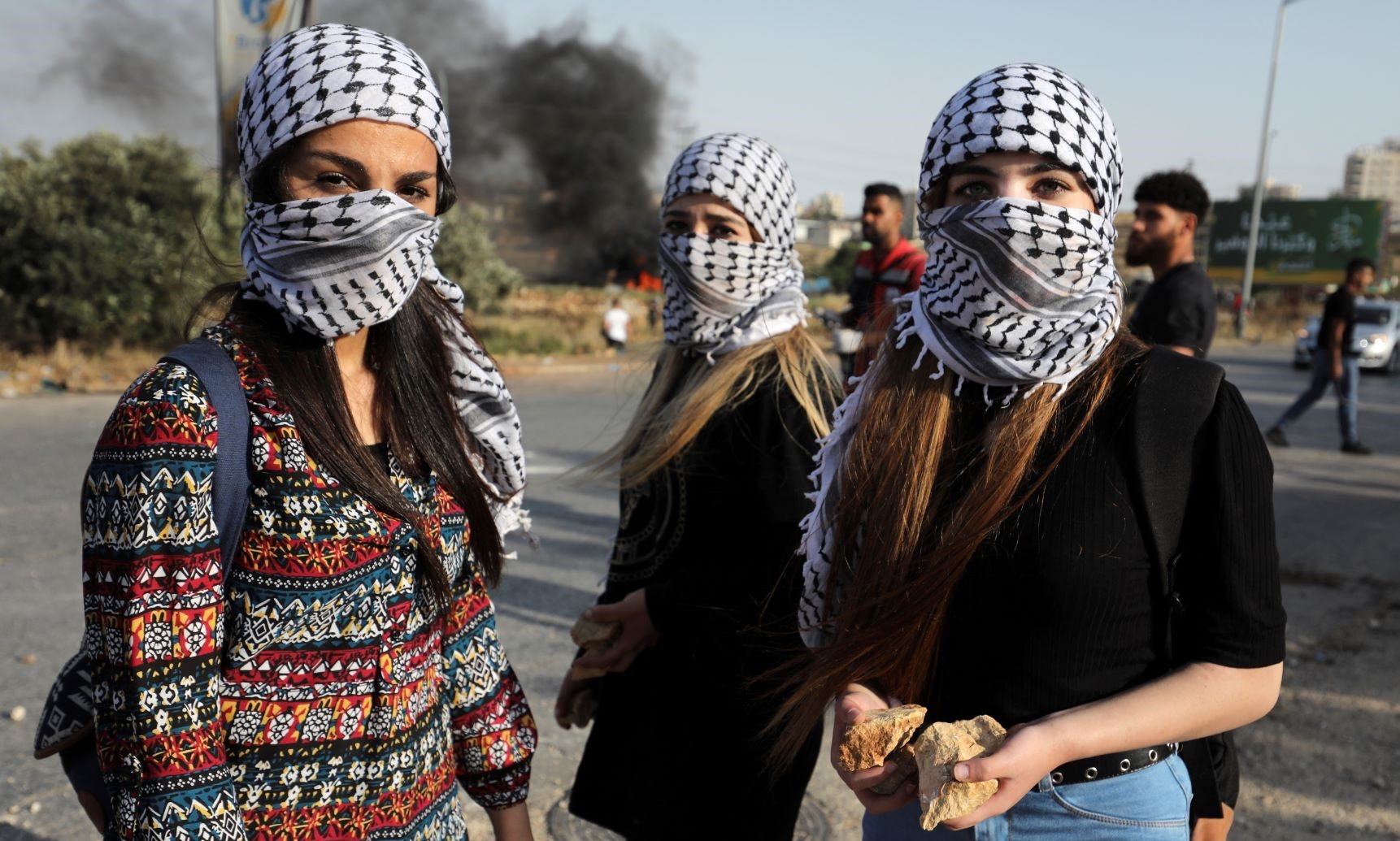
A distinctly Palestinian black-and-white chequered piece of cloth, the keffiyeh is described by some as the nation's unofficial flag.
Long synonymous with the Palestinian cause, the simple square-metre fabric, traditionally folded diagonally into a triangle and worn draped over the head of rural Palestinian men, is today securely fashioned around the necks of human rights activists, anti-war protesters, sports stars and celebrities; transcending gender, religion and nationality.
Muhammad Walid, 49, from Jerusalem says he remembers seeing his father and uncles wear the keffiyeh in his earliest memories.
"The older generations would wear it on their heads," he says. "I started wearing it as a teenager, but around my neck. For me, it represents the Palestinian struggle and cause."
It's a similar story for Riad Halak, 62, also from Jerusalem, who says: "It's a tradition of Palestine. I started wearing one when I was 11 years old, and I still wear it today on special days like the Nakba. It's part of my identity."
While the keffiyeh's status as an icon of Palestinian nationhood is undisputed, its origins lie further east, in what is now Iraq.
The word itself means "relating to Kufa," a reference to the Iraqi city south of Baghdad that sits along the Euphrates river, but little else is known about the roots of the keffiyeh. One account suggests it came about in the seventh century, during a battle between Arab and Persian forces near Kufa. The Arabs were said to have used cords made from camel hair to secure their headdresses and in order to recognise their comrades in the heat of battle. After their victory, the headgear was kept on as a reminder of their triumph.
Others say the fabric, sometimes called the hata in the Levant, has origins that pre-date Islam and can be traced back to Mesopotamia, when it was worn by Sumerian and Babylonian priests around 5,000 years ago.
"Its origins are open to speculation," Anu Lingala, author of A Socio-political History of the Keffiyeh, tells Middle East Eye. "Until very recently, these types of designed objects were not taken seriously as subjects of academic research. The exception was for designed objects that were associated with elite status and wealth, whereas the keffiyeh was traditionally associated with working classes."
Shorthand for the struggle
Although no longer linked to social status, the keffiyeh's modern roots in Palestine are among the fellah, or rural workers, as well as the Bedouin. The two groups would wear the garment over their heads to cover the backs of their neck and protect themselves from the heat of the summer sun and the cold during the winter.
According to Lingala: "Covering one's head was an important principle in traditional Palestinian culture.
"[The keffiyeh] afforded breathability through air pockets created by folds in the fabric," she says.
The more educated, urban Palestinians, or effendi, would wear the fez or tarboush, a deep-red felt hat popularised by Ottoman ruler Mahmud II and adopted by locals as a standard form of dress.
Cultural historian Jane Tynan has written about the scarf's significance in the book Fashion and Politics. She says: "The Ottoman Empire's dress codes had the effect of erasing ethno-religious identities, but would have been worn as a norm by urban dwellers."
After the Turkish empire's loss of its Near Eastern territories during the First World War, and the Arab Revolt against British colonial rule in 1936, Palestinian nationalists also used the keffiyeh as a means of covering their faces to hide their identity and avoid arrest, spurring unsuccessful calls among the British to ban the headscarves. Instead, in a "pivotal moment in Palestinian culture," Palestinians united in adopting the fabric as a sign of solidarity. The symbol remained a staple icon of Palestinian nationhood after the Nakba and the establishment of the state of Israel.
"Palestinians of all social classes abandoned the fez and united around wearing the keffiyeh, making it difficult to identify the revolutionaries," Maha Saca, head of the Palestinian Heritage Centre in Bethlehem, tells Middle East Eye.
Tynan, an assistant professor in design history and theory at Vrije Universiteit Amsterdam, says that "from its function in the revolt as a tool to disguise the identity of the wearer from British authorities, the keffiyeh became shorthand for the Palestinian struggle".
Lingala makes a similar point: "As Palestinians' collective identity and right to the land continued to be increasingly threatened... they sought to hold onto items that represented 'cultural continuity'."
Years later, in the 1960s, the late Palestinian leader Yasser Arafat popularised the garment among a global audience. According to Saca: "Abu Ammar [Arafat] would never be seen at any event without it."
His keffiyeh was always carefully positioned on his head, with the longer end of the fabric placed over his right shoulder – some say it was laid out to resemble a map of pre-1948 Palestine.
When Israeli occupation authorities banned the Palestinian flag from 1967 until the Oslo Accords in 1993, the scarf took on a potent symbolism, according to Ted Swedenburg, professor of anthropology at Arkansas University.
"Portable and visible symbols" were important to Palestinians, Swedenburg says, adding that with the flag banned by the occupation for alomost 30 years, the keffiyeh, "to which so much rich symbolism and history was attached, served as an everyday, portable, visual expression of Palestinian identity".
Wheat, olives and honey
The distinct black stitching on the white cotton keffiyeh is said to have many symbolic meanings, and although none have been verified, Palestinians have no shortage of interpretations.
It has been described by some as "a fishing net, a honeycomb, the joining of hands, or the marks of dirt and sweat wiped off a worker's brow". Others suggest the design represents ears of wheat, in reference to Jericho, one of the first known cities to cultivate the grain.
Palestinian performance artist Fargo Tbakhi adds "barbed wire" to the list, explaining the pattern could depict "that ever-present symbol of the occupation," although he relates most to the fishing net design, also called the fatha (opening).
"[I see it] as a symbol of our identity, a model for being Palestinian, it articulates one possible futurity for our people," he writes in the Los Angeles Review of Books.
"A fishnet is an image of collectivism, of entanglement and dependence: in a net, singular strands become something larger, stronger. As one strand, I am always yearning to be knotted together with others, so that we are better able to hold, to catch."
Palestinian author Susan Abulhawa tells Middle East Eye that the patterns on the keffiyeh "speak to Palestinian lifeblood, in the same way that the patterns of tatreez [Palestinian embroidery] is a language unto itself, telling stories of location, lineage, occasion, and historic significance".
The black stitching is sometimes also referred to as a honeycomb design, in recognition of the region's beekeepers; some rural Syrians (where the cloth is also worn) say the pattern symbolises the joining of hands and the marks of dirt and sweat wiped off a worker's brow.
A recent tweet included another interpretation of the design, a representation of Palestine's olive trees, which show "strength and resilience":
Abulhawa agrees: "The 'bird-like' motifs along the border are interconnected olive leaves, referring to the significance of the olive tree in Palestinian life."
Olives, in all forms - olive oil, olive-oil products (such as soap), and olive wood - were hugely important aspects of Palestinian culinary, social and economic life, Abulhawa explains.
"Olive trees provided not just a means of sustenance and income, but the care of trees and harvest season provided for important social and national events in our society. Olives are present in our poetry, songs, tatreez, food, folklore, and familial lore. Finally, the geometric long borders in the keffiyeh denote the trade routes that both imported and exported products to and from Palestine."
Not always black and white
Thought to have been originally made out of wool, before cotton was introduced from India and Egypt, the keffiyeh - also called the shemagh in Jordan and Syria, and the ghutra in Gulf countries – remains distinctly Arab but is non-religious, as Arab Christians, Muslims, Druze and secular people wear it across the region, in different colours and designs.
While the Palestinian and Syrian scarf is black and white, others have their own patterns.
Gulf countries like Bahrain, the UAE and Qatar favour a plain white ghutra, a spotless light cotton garment that acts as a barrier to the year-round heat. In the cooler winter months, a heavier fabric in darker, muted shades replaces the summer headwear. It's usually draped over the head and secured with a black igal cord, and younger men may choose to wrap the ghutra in a turban style known as hamdaniya.
Saudis and Jordanians wear a red-and-white chequered shemagh, said to have been influenced by the British.
British General John Bagot Glubb is said to have designed the headdress in the 1930s, as a way to distinguish Arabs loyal to British rule, according to academics Widad Kawar and Ezra Karmel. Manufactured in British cotton mills, it soon became part of the uniform of Britain's colonial rule, the Palestine Police Force.
A version without the distinct Jordanian tassels later entered Saudi Arabia, where it's also wrapped and twisted in different styles.
Freedom to fashion
Students and anti-war campaigners around the world began adopting the Palestinian keffiyeh as part of the anti-war movement in the 60s and 70s. Swedenburg says it was at this time that it transcended the Arab world and became a garment of choice among political protesters and anti-missile advocates, and a symbol of resistance worn by other anti-imperialists, like the late Cuban leader Fidel Castro.
Castro wore it, and so did Nelson Mandela. Swedenburg says: "Pretty much all left-wing forces were in solidarity with the Palestinian struggle... Che [Guevara] visited the Gaza Strip in the years before he died."
There was widespread sympathy with the anti-colonial and anti-imperialist struggles in the developing world.
"Starting with the Vietnamese struggle," says Swedenburg, "but also Chile's socialist experiment under Allende, the armed struggles in Mozambique and Angola against Portuguese colonialism, the struggle against apartheid in South Africa, and so on.
"So there was a segment of the anti-war movement, particularly in the leftist and anti-imperialist segments, that was in solidarity with the Palestinian resistance movement, and so one saw keffiyehs around in these circles."
The garment easily transitioned to mainstream fashion thereafter. Lingala references a Time Magazine article from 1988 that discusses the Palestinian keffiyeh in American street style and in relation to the first Palestinian intifada, which began in 1987.
"Keffiyeh wearers interviewed for the piece were unaware of any political affiliations and instead wore it as an accessory," Lingala states.
The garment also featured in Is Fashion Modern?, a 2017 exhibition at New York's Museum of Modern Art. Its senior curator said: "[The keffiyeh] has become imbued with deep political significance. It has also become a fashion accessory that is, in some iterations, completely divorced from its original context and used for its aesthetic merits alone."
However, mainstream adoption of the scarf has not translated into success for Palestinian manufacturers. Local Palestinian keffiyeh factories have shut down as the scarf began being mass produced in places such as China.
The Hirbawi family, manufacturers of the traditional keffiyeh since 1961, soon found the cheaper versions were undercutting their products, which are manufactured in Hebron, known as Al-Khalil to Palestinians.
In an earlier interview, Abed, one of the brothers running the factory, told Middle East Eye: "When keffiyehs made in China began arriving, our looms fell silent." As demand for Palestinian-made keffiyehs shrunk, so did production. It took another 15 years for it to pick up again.
This perceived "cheapening" of the keffiyeh and the stripping of its symbolic values has led to accusations of cultural appropriation. In addition to the mass-market products, high-end designers have produced their own iterations, including Balenciaga's version in 2007, which cost $3,000, as well as versions by Chanel and Fendi.
Singing for solidarity
That commercialisation of the keffiyeh has by no means lessened its cultural value in the eyes of Palestinians.
British Palestinian rapper Shadia Mansour, for example, has insisted the keffiyeh's symbolic attachment to Palestinian identity must be recognised and remembered and has made references to the scarf in her work. She released her first single Al-Kufiyyeh 3arabeyyeh, meaning The Keffiyeh is Arab, in 2010 as an ode to the garment and to her identity.
Fellow Palestinian artist Mohammed Assaf won the Arab Idol talent show in 2013 with his song in praise of the garment, Ali al-Kuffiyeh, or Raise your Keffiyeh, which became a Palestinian anthem. More recently, Palestinian singer Muhannad Khalaf’s Filisteen, Taj Ala-Raas or Palestine, Crown on the Head, features dancers wearing the keffiyeh and performing the traditional debka dance.
This article is available in French on Middle East Eye French edition.
Middle East Eye propose une couverture et une analyse indépendantes et incomparables du Moyen-Orient, de l’Afrique du Nord et d’autres régions du monde. Pour en savoir plus sur la reprise de ce contenu et les frais qui s’appliquent, veuillez remplir ce formulaire [en anglais]. Pour en savoir plus sur MEE, cliquez ici [en anglais].


